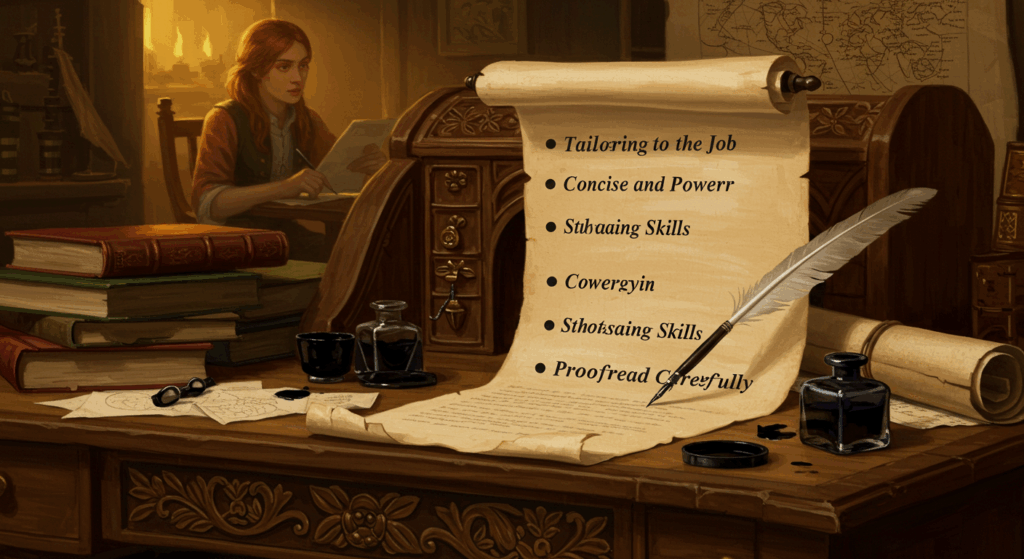If writing a cover letter makes you want to crawl under a blanket and pretend the job posting never existed… valid. Same. But also: this little note can seriously shift the odds in your favor. Think of it like the message you send on a dating app before the first coffee—short, specific, and designed to make the other person go, “Okay, I want to meet them.” The resume is your profile; the cover letter is the vibe check.
We’ll walk through the purpose of a cover letter (what it’s actually for), the structure (how to organize it without getting sweaty), and very real, no-fluff tips you can use today—even if you’re starting from a blank page and a cold brew that’s mostly melted ice. I’ll give you lines you can borrow, examples for tricky situations (no experience, career change, layoffs), formatting moves, and sneaky edits that improve your chances. We’ll keep it chatty, honest, and ngl, a bit imperfect—because you’re not a robot, and hiring managers aren’t either.
First: What’s the Actual Purpose?
Let’s be blunt: the purpose of a cover letter is not to repeat your resume. It’s to make somone curious enough to interview you. That’s it. It bridges the gap between bullet points and real-world impact, and it answers three questions:
- Why them? Show you get their business, product, or pain point.
- Why you? Highlight 1–2 moments that prove you’ll do this job well.
- What now? A polite, confident nudge toward the interview.
Think of it like a TikTok hook: “Wait—don’t scroll. Here’s the one reason I can help you hit X goal in the next Y months.” When you show you understand their world (not just your achievements), you’re already ahead of 80% of applicants who fire off generic letters and pray to the ATS gods.
The 10-Minute Brain-Prep (Do Not Skip)
Before you write, spend 10 minutes collecting receipts:
- One business priority you suspect they care about (grow paid subscribers, reduce churn, improve on-time delivery, ship new features faster).
- One specific proof from your past that aligns with that priority (a metric, a project, or a mini case study).
- One sentence showing you actually looked at their product/site/app or recent news (“Noticed you launched the Freemium plan last month; I have ideas to convert free users based on my A/B work at X”).
If you do just this, your letter will already sound 10x more relevant than the “To whom it may concern, I am writing to express my sincere enthusiasm…” stuff. (Please… no.)
The Simple Structure That Works (Always)
I promise you don’t need a fancy template. Here’s a structure that’s clean, skimmable, and manager-friendly:
- Header & Greeting
- Your name, phone, email, LinkedIn/portfolio (optional if you have it in the resume already).
- Date.
- Hiring manager name + company (or the team name if manager unknown).
- Greeting: “Hi [Name],” (If truly unknown: “Hi [Team]” or “Hello [Company] Hiring Team]”). Skip “To whom it may concern” unless you’re writing from a castle in 1840.
- Opening: The Hook (2–3 sentences)
Lead with something about them—a product, mission, challenge. Then pivot to the one or two reasons you’re useful right now. Quick and confident. - Middle: Proof in Action (1 short paragraph or 3–4 bullets)
Show mini outcomes that match the job’s needs. Include numbers if you can. Make it easy to skim. - Closing: Momentum + Call to Action (2–3 sentences)
Wrap with confidence, signal availability, and thank them. Optionally, add a P.S. with a bonus link or quick idea. - Signature
Your name. That’s it. Simple is classy.
A Fill-in-the-Blank Template (Steal This)
Use this as your base. Swap the bracketed parts.
Opening paragraph
Hi [Hiring Manager Name],
I’m excited about [Role] at [Company]—especially after [one sentence about their product, mission, or a recent initiative]. In my last role at [Previous Company], I [1-line impact that mirrors the job], and I’d love to bring that to your team.
Proof paragraph (choose paragraph or bullets)
Recently, I [one project: what you did → result].
- [Short bullet with metric/result tied to the job]
- [Short bullet with process/skill they asked for]
- [Short bullet showing collaboration or speed]
Closing paragraph
I’m especially drawn to [Company] because [true reason tied to values, product, or user base]. I’d love to share a few ideas for [priority you spotted] and how I’d ramp in the first 60 days. Thanks for your time—looking forward to connecting.
Signature
Best,
[Your Name]
Optional P.S.
P.S. Here’s a quick [portfolio link/case study/1-page outline] relevant to [their feature, campaign, or challenge].
Notice how the structure keeps the letter easy to scan. Managers read in 15–45 seconds. Make those seconds count.
Openers That Don’t Sound Like a Bot
Try one of these tips for first lines. Your goal is warmth + relevance:
- “I loved your recent update on [feature/news]; as someone who’s shipped [similar thing], I’d be excited to help scale it.”
- “You’re tackling [challenge]? That was my jam at [Company], where I [result].”
- “Noticed your app rating jumped after the July update—congrats. I’ve helped teams maintain momentum post-launch, and I’d like to do that here.”
Avoid: “I am writing to express my strong interest…” (We know. You’re writing.)
What to Emphasize (Match the Job to Your Story)
Your letter should show the purpose: connecting your past impact to their current needs. Pull 2–4 requirements from the posting and mirror them with short, outcome-based lines:
- If they want growth: mention acquisition, retention, LTV, conversion rate, pipeline influence.
- If they want operations: mention on-time delivery, error rates, cycle time, SLA adherence.
- If they want creative/brand: mention engagement, watch-through rate, style guides, cross-channel consistency.
- If they want engineering: mention performance improvements, reliability, reduced complexity, delivered features, mentor/ownership moments.
- If they want customer roles: mention CSAT/NPS, resolution time, renewals, expansion.
One sentence per outcome. Numbers if you have them. Real > perfect.
Strong Bullets You Can Adapt
- Increased [metric] by [X%] in [Y months] by [tactic], leading to [business result].
- Launched [project/feature] with [tools/stack], reducing [time/cost/errors] by [X%].
- Collaborated with [teams] to [action], which [outcome].
- Built [system/process] that scaled to [volume/traffic/users].
- Trained [X] teammates, improving [quality/speed metric].
These say more than “I am detail-oriented” ever will (lol).
Formatting That Passes the Vibe (and ATS) Check
Even though a cover letter is human-facing, it still gets stored and sometimes skimmed by ATS. Keep it clean:
- One page max. Half a page is often perfect. If you’re writing a novella, pause and cut.
- Readable font size (11–12pt) and standard fonts (Arial, Calibri, Georgia).
- File type: PDF is safest unless they ask for something else.
- No heavy design needed. Save your creative chaos for the portfolio.
- Name the file like a pro:
Jordan-Ali-Cover-Letter-Product-Manager-Spotify.pdf. - Email version: paste as plain text below your greeting; attach the PDF too.
This structure keeps your letter scannable and tidy—exactly what a busy hiring manager needs.
Timing, Length, and Tone (Real Talk)
- When to submit: Ideally within 1–3 days of the posting, but later is still fine if you’re strong.
- Length: 200–350 words is a sweet spot. You’re telling a story, not writing your memoir.
- Tone: Confident but friendly. Avoid corporate-robot voice. Think: “respectful coffee chat.”
A good vibe matters. Hiring is a people game.
Situational Playbook (Use What Fits)
If You’re Entry-Level or Have “No Experience”
You do have experience—projects, internships, clubs, part-time work, community stuff. Tie your story to the job’s purpose:
“As the lead for our campus hackathon, I coordinated 12 sponsors and 150 participants, solving the exact chaos I’d handle in this coordinator role—vendors, logistics, and comms under pressure.”
Translate school → work: scope, responsibility, outcomes.
If You’re Changing Careers
Pivot letters should connect transferable skills:
“In retail I learned to turn angry customers into loyal ones. In CX at your company, I’d bring that same energy—fast de-escalation, clear documentation, and a habit of sharing patterns with product so we fix root causes.”
Show you’ve done homework on the role’s structure—tools, workflows, KPIs.
If You Were Laid Off or Have a Gap
No need to over-explain:
“After a company-wide layoff in April, I took 8 weeks to upskill in [tools/certificates] and built [project]. I’m ready to bring those fresh skills to [Company].”
Own it with calm confidence.
If You Have a Referral
Name-dropping (politely) is gold:
“I recently spoke with [Employee Name] on the [Team], and their view of your roadmap got me fired up to contribute to [X initiative].”
This immediately boosts credibility.
If You’re Freelance/Contract
Clarify impact and cross-team wins:
“As a contractor for [Client], I shipped [result] across marketing, product, and data—exactly the multi-team coordination your role requires.”
Advanced Tips to Level-Up
1) Mirror Their Language (Lightly)
Scan the job post for keywords: tools (Figma, Python, Salesforce), methods (OKRs, Kanban), outcomes (activation, retention). Use a natural sprinkle—don’t keyword-stuff. This helps with both humans and ATS.
2) Anchor to a Business Priority
Replace vague phrases (“team player”) with outcomes:
- “Shorten the onboarding loop”
- “Improve activation within the first session”
- “Increase forecast accuracy”
- “Reduce time-to-first-value”
That signals you think like an owner. The purpose is impact, not tasks.
3) Share a Tiny Idea (Carefully)
One line is enough:
“If helpful, I’d prioritize a quick journey audit focused on [step], testing [hypothesis] to lift [metric].”
Don’t hand them free consulting; just show how you think.
4) P.S. for Extra Context
A tasteful P.S. can boost replies:
“P.S. Here’s a 1-pager with three onboarding tweaks I used to lift activation by 11%.”
5) Customize the First 20%
If you’re batch-applying (we’ve all been there), at least customize the opener and the first proof line. That’s where eyes go.
What to Avoid (Red Flags)
- Repeating your resume. Your letter should connect the dots, not copy them.
- Being generic. If your letter could apply to 50 companies, it’s not doing the job.
- Over-apologizing. Don’t list all the things you lack. Emphasize what you bring.
- Jargon soup. If a sentence makes you yawn, rewrite it.
- Typos in names. Triple-check the company and manager spelling. Please.
- Attaching without context. If you include a portfolio, pick 1–2 relevant links, not twenty-seven.
Examples You Can Remix
Example A — Marketing Coordinator (Early Career)
Hi Maya,
Your push into community-driven content at GlowUp is smart—loved the creator playbook you launched last month. At my campus org, I built a micro-influencer program from scratch: 14 student creators, a weekly calendar, and a simple UTM system to track sign-ups. Over one semester we grew event attendance 38% and newsletter CTR from 2.4% to 4.1%.I’m comfortable planning content sprints, tracking metrics in Sheets/GA4, and collaborating across design and events. I’d love to help GlowUp scale authentic creator partnerships while keeping the workflow lightweight. Thanks for considering—I’d be excited to share a 30-60-90 plan.
Best,
Taylor
Why it works: Leads with their strategy, stacks two outcomes, mirrors job language (calendar, UTM, CTR), and keeps the structure compact.
Example B — Product Manager (Career Switch from Ops)
Hi Arun,
I’m applying for Associate PM at Northbeam. I noticed your team is doubling down on activation—smart move. In operations at Dropcart, I owned a cross-functional project to reduce time-to-fulfillment. By mapping the top 5 blockers and piloting a lightweight SLA dashboard, we cut cycle time 22% in two months.The PM craft I bring is ruthless prioritization, clear tickets, and fanatical user empathy—plus a bias to ship, then iterate. I’d love to apply that to activation experiments this quarter. Thanks for your time.
Best,
Sam
Why it works: Ties ops outcomes to product outcomes, shows PM mindset, focuses on purpose (activation, shipping).
Example C — Customer Support (Gap/Laid Off)
Hello Support Team,
After a company-wide layoff at Hummingbird in June, I used the summer to complete an advanced Zendesk course and logged 50 hours volunteering for a local nonprofit’s help desk. I’m applying for your Support Specialist role because your “humans-first” pledge resonates—and because I’ve handled 60–80 tickets/day while keeping CSAT above 95%.I specialize in calm de-escalation, tight documentation, and closing the loop with product on recurring issues. If helpful, happy to share brief notes on my macros and tagging system. I’d love to help keep your queue fast and friendly.
Thanks,
Riley
Why it works: Addresses the gap, offers concrete proof, and reflects their values.
Email vs. Attachment (Tiny but Mighty Details)
- If the application has a field for your letter, paste the text and upload the PDF so formatting is preserved.
- If you’re emailing a recruiter/hiring manager, your cover letter can be the body of the email. Keep the greeting, cut the address block, and attach your resume + portfolio.
- Subject line idea:
Application: [Role] — [Your Name]orReferred by [Name]: [Role] — [Your Name].
Using AI (Without Sounding Like AI)
You can ask AI to draft a first pass or help with phrasing—totally fine. Then make it yours:
- Add 1–2 specific details about the company (feature, audience, mission).
- Swap generic verbs (“collaborated”) for real actions (“paired with design to ship X”).
- Read it out loud. If it sounds like a press release, rewrite until it sounds like a person who likes their job and has coffee breath. (hmm, tmi?)
AI is a tool; your judgment is the value.
Quick Quality Checklist (Skim Before Sending)
- Did I mention their product, users, or goal?
- Did I include 1–2 proof points with outcomes?
- Is the structure easy to scan (short paragraphs, optional bullets)?
- Did I avoid clichés and add a human voice?
- Are the names/links/file names correct?
- Is it under one page?
- Does it end with a confident call-to-action?
If you can check those boxes, you’re good.
Common Questions (You’re Not Alone)
Do I always need a cover letter?
Not always. But if the posting or application form asks for one, do it. And if you’re switching careers, have a gap, or want to stand out at a popular company, the letter is where you win hearts.
How long should it be?
200–350 words. If your mom would say “too long,” it probably is.
What if I don’t have metrics?
Use outcomes without numbers: “Shipped ahead of schedule,” “Consistently handled high-priority tickets,” “Drove adoption with a 3-step onboarding flow.”
What if I can’t find the hiring manager’s name?
Use the team or role: “Hi Data Platform Team,” or “Hello Customer Experience Hiring Team.”
A Note on Voice, Confidence, and Being Human
You do not need to sound like LinkedIn in a suit. Friendly confidence beats stiff formality. Small imperfections are cool; just be respectful and clear. And if you’re feeling impostor syndrome (hi hello), remember: hiring is not a morality test. It’s matchmaking. Your job is to help them see the match.
If you want to add a dash of personality (a very light dash), try micro-lines like:
- “I’m the kind of person who opens a spreadsheet for fun (I know).”
- “I keep meetings short, docs long, and my playlists full of lo-fi when I’m bug-hunting.”
- “Not to brag, but my label maker has a name.”
Tiny humor shows there’s a person behind the application. Just… read the room and the industry. Finance? Tone it down. Startup creative? Go a little brighter.
Putting It All Together (Mini Walkthrough)
Let’s say you’re applying to a SaaS company focused on small-business tools. The posting mentions: onboarding flows, activation, and cross-functional collaboration.
- Hook with purpose: “I’m excited about your mission to simplify SMB ops—especially your new onboarding checklist. At Acme, I led a similar push and lifted week-one activation by 13%.”
- Proof that matches structure: “Partnered with design and data to test three variations; reduced time-to-first-action by 22%. Built a segment-based email nudge that doubled completion of step two.”
- Close with a tip: “I’d love to help you continue that momentum. If useful, I can share a quick 30-60-90 outline tailored to your current checklist.”
Short, aligned, confident. That’s the sauce.
Rapid-Fire Tips (Pin These)
Because you asked for tips, here’s a quick-hit board:
- Purpose: Make them curious enough to interview you by connecting their priority to your proof.
- Structure: Greeting → Hook about them → 1 paragraph or 3–4 bullets of proof → Confident close → (Optional P.S.).
- Use numbers when possible; if not, describe the before/after.
- Mirror 2–4 keywords from the job post naturally.
- Customize the first 20% of your letter for each company.
- Keep it under a page, ideally ~300 words.
- Send as PDF with a clean file name.
- Add a P.S. if you have a tightly relevant asset.
- Read it out loud once. If you trip, cut or simplify.
- End with a CTA: “Would love to connect,” “Happy to share a 30–60–90,” etc.
Tiny Library of Borrowable Lines
- “I’m especially drawn to [Company] because [user base/mission], and I’d love to help [team] hit [goal] this quarter.”
- “I prioritize clear documentation and fast iteration—ship, learn, improve.”
- “In [past role], I focused on [metric]; here, I’d apply that to [similar metric], starting with [first experiment/system].”
- “I’m comfortable collaborating across [teams]; my favorite wins happen when we simplify a complex process and watch the numbers move.”
Use these as seasoning, not the whole dish.
One More Polished Example (Just to Show the Flow)
Hi Jamie,
I’m applying for the Operations Analyst role at Parcelly. Your focus on on-time delivery and reducing exception rates is spot on; it reminds me of a project I ran this spring where we cut delayed shipments by 19% in 90 days.
I partnered with engineering to instrument better scans, revamped our pick-pack checklist, and introduced a lightweight morning huddle that flagged inventory gaps before they derailed the day. The result was a cleaner handoff and fewer “fire drills.” I also love building dashboards people actually use—my last one became the team default in under a week.
I’d be excited to bring that same bias for clarity and speed to Parcelly. If hewlpful, happy to share a one-pager outlining a 60-day plan to stabilize exceptions across your top three lanes. Thanks for your time.
Best,
Casey
Short, relevant, confident. No fluff.
Final Edit Pass (Trust the Process)
When you think you’re done, do one last pass:
- Cut the first sentence (most people start too slow).
- Swap adjectives for specifics (“significant growth” → “14% MoM”).
- Make the close confident, not needy (“I’d be thrilled to interview” → “I’d love to connect and share a 30–60–90.”).
- Check for emotionless filler (“I believe that I…”). Tighten to: “I can,” “I did,” “I will.”
Then… send it. Don’t over-bake. Netflix can wait 15 minutes, promise.
Wrap-Up: You’ve Got This
A great cover letter isn’t about being perfect—it’s about being relevant. Keep the purpose front and center (why them, why you, why now), use a clear structure that’s simple to skim, and apply a few practical tips to personalize without spending five hours per application. You’re not trying to win a Pulitzer; you’re trying to start a conversation.
If you’re still staring at the cursor, I’ve got you: open a new doc, paste the template above, fill in three lines about their priorities, add two proof points from your world, and hit send. Ngl, you might be surprised how often “good, human, and specific” beats “perfect and generic.”
You’ve got the skills. Let’s go get the interview. 💪Thinking









